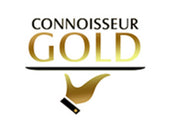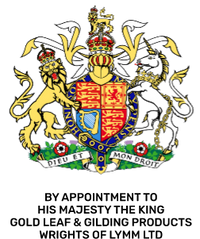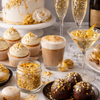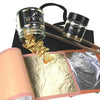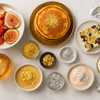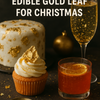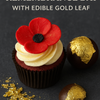The Ultimate Guide to Edible Gold Leaf & Silver: Explore Decadence in Dining with Connoisseur Gold | 24ct, Dust, Flakes
- by sam@wrightsoflymm.co.uk User
A Taste of Treasure: Exploring the Luxurious World of Edible Gold and Silver
The pursuit of luxury in dining has transcended flavour, moving into the purely visual and the spectacularly decadent. For centuries, one element has stood apart as the ultimate symbol of opulence on a plate: the precious metals, gold and silver. From the ancient Egyptians to the lavish banquets of the European Renaissance, adding shimmer to food has been a mark of wealth, power, and high celebration. Today, this tradition is more accessible than ever, allowing home bakers and professional chefs alike to transform their creations with the magnificent gleam of edible gold and silver.
But what exactly are these culinary treasures, and how can they be safely and effectively incorporated into your recipes? Dive into the shimmering world of gold leaf and silver leaf and discover how to add true star power to your next culinary masterpiece.
What Makes Gold and Silver ‘Edible’? The Science of Sparkle
The most common question surrounding these metallic garnishes is undoubtedly: is it safe to eat? The answer is a resounding yes, provided you use products specifically manufactured and certified as "edible."
The safety of consuming gold and silver lies in their purity and chemical nature. Edible gold must be of a high karat, typically between 23ct and 24ct. This high purity ensures the gold is chemically inert, meaning it will not react with your body or be absorbed during digestion. It passes through the digestive system unchanged, offering zero nutritional value but maximum visual impact. In the European Union, edible gold is classified as a food additive under the code E175.
Similarly, silver leaf is also safe to consume when it is the food-grade, non-ionic form (E174). Just like its golden counterpart, edible silver is biologically inert, designed to pass through the body without any interaction. It is absolutely crucial to distinguish certified, food-grade metals from non-edible versions (often called ‘composition leaf’ or 'metal leaf') used for craft or decoration, as the latter can contain toxic impurities and harmful alloys. Always source your goldleaf and silver from reputable culinary suppliers.
The Many Forms of Edible Metals: From Leaf to Dust
Edible gold and silver come in a variety of forms, each best suited to different culinary applications. Understanding these formats is the key to achieving the perfect, opulent finish on your dishes and drinks.
1. Gold Leaf and Silver Leaf
The most classic and dramatic form is the gold leaf or silver leaf. These are ultra-thin sheets of metal, sometimes only fractions of a micron thick, available in loose sheets or 'transfer' sheets.
-
Application: The sheer size of the sheets makes them ideal for covering large, smooth surfaces, such as entire wedding cake tiers, chocolate bars, or elegant savoury dishes like a famous saffron risotto.
-
Handling: Due to their delicacy, gold leaf sheets require special care. Chefs use soft brushes, specialized transfer paper, or tweezers to apply the metal to surfaces lightly dampened with edible glue, clear alcohol, or a thin layer of icing. The slightest breath or touch can tear this paper-thin luxury.
2. Gold Flakes and Silver Flakes
Gold flakes and silver flakes are small, irregular pieces of the precious metal. These offer a more scattered, textured shimmer and are significantly easier to handle than the leaf.
-
Application: Flakes are incredibly versatile. They are perfect for sprinkling over frosted cupcakes, adding to dessert platters, or incorporating into clear substances. A favourite application is adding a spectacular 'snowglobe' effect to spirits, champagne, and cocktails—the flakes will dance mesmerically in the liquid.
3. Gold Dust and Silver Dust
The finest of the edible metals, gold dust and silver dust provide a more subtle, all-over glimmer.
-
Application: Gold dust and silver dust are primarily used to add a brilliant sheen. They can be brushed directly onto chocolates, fondant, or gum paste to highlight intricate details. Alternatively, mixing the gold dust with a clear liquid (like vodka or lemon extract) creates a luxurious metallic paint for hand-painting designs onto cookies or cake decorations.
Elevating the Plate: Culinary Applications
The use of these metals is limited only by imagination. While once reserved for only the most elite of dishes, today's chefs and ambitious home cooks are finding new ways to integrate the gleam of 24ct and 23ct metals.
In the world of pastry, edible gold transforms cakes into show-stopping centrepieces. A simple chocolate truffle becomes an irresistible bite of luxury when topped with gold flakes. Savoury applications are equally impressive; think of a light dusting of silver dust over an oyster or a delicate scattering of goldleaf on sushi.
The bar scene has also embraced the trend, with mixologists creating 'millionaire' cocktails adorned with gold dust or tiny silver flakes floating in champagne, adding an element of theatre to the drinking experience.
The Timeless Appeal of Decadence
Ultimately, edible gold and silver serve a singular purpose: aesthetic enhancement. They appeal directly to the sense of sight, transforming a simple culinary creation into an experience of unbridled luxury and unforgettable glamour. While they do not alter the taste of the food—a good thing, as you want the flavour of your ingredients to shine—they elevate the perceived value and sophistication of the moment.
Whether you opt for the bold coverage of gold leaf on a celebratory cake or the delicate shimmer of silver flakes in a glass of prosecco, these precious metals are the ultimate secret weapon for any host looking to truly dazzle their guests. When choosing your sparkle, remember: always select certified edible gold of 23ct or 24ct purity or pure silver, and prepare to unleash a little bit of ancient opulence on your modern table.
